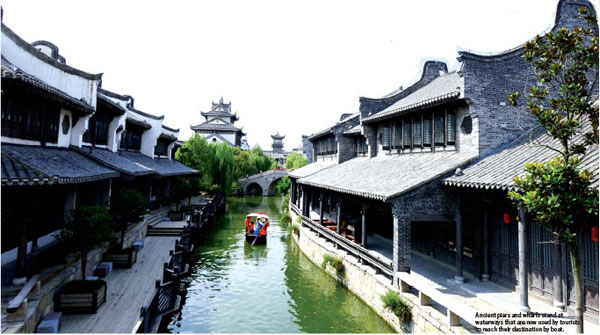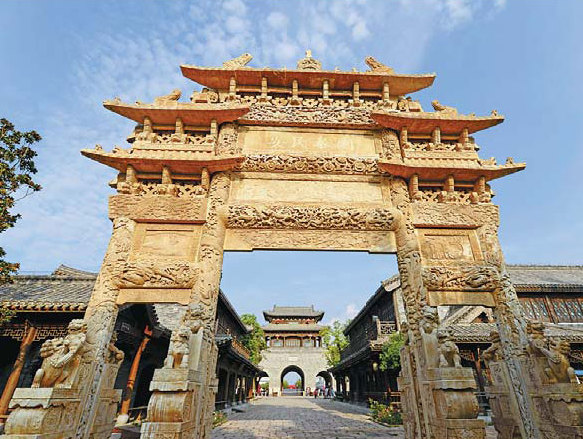

Ancient piers and wharfs stand at waterways that are now used by tourists to reach their destination by boat.

A recreation of ancient arch in the historic town Tai'erzhuang is well-known for its exquisite and complicated stone carves. Photos by Ju Chuanjiang / China Daily
The ancient city of Tai'erzhuang combines tangible landscape and intangible culture.
As we entered Zaozhuang, a city in the southwest Shandong province, I couldn't help but note that what I'd expected was wrong. I had assumed the city, which is heavily dependent on coal-related business, would be smoggy. Instead, I found a city that has clean roads with large trees and lush lawns on both sides. The sky was also blue the day we visited, making the city's environment very comfortable. Our destination was Tai'erzhuang, a town located in the old part of Zaozhuang. On Aug 15, local authorities officially announced the town has been recreated as closely as possible to its condition before it was mostly destroyed in 1938 during the War of Resistance against Japanese Aggression (1937-1945). The recreated town is rated a 5A tourist attraction, the top ranking in China's five-level tourist site evaluation system.
As we walked through the town gate, we encountered "Emperor Qianlong" (1711-99), who paraded along the main street of the town with his empress and dozens of attendants. "I feel like I've traveled back to the Qing Dynasty (1644-1911)," my companion says.
"There are people dressed in costumes parading around the town every day to create a historic ambience," says Ren Sinian, our guide.
The real emperor called Tai'erzhuang "the most affluent town in the world" when he stopped by on his way to south via canal, according to The Annals of Yi County, published in 1904.
Tai'erzhuang was established in the Han Dynasty (206 BC-AD 220), but didn't thrive until 1604 when a canal was built through the town as part of the Beijing-Hangzhou Grand Canal. The Annals of Yi County records that around 10,000 boats passed through Tai'erzhuang on the canal every year, making the town an important transport base during the Ming (1368-1644) and Qing dynasties.
Thanks to the canal, businessmen around the country converged at Tai'erzhuang, leaving great legacies to the town, such as more than 6,000 houses featuring different architectural styles.
Most of the town was leveled, however, during the Battle of Tai'erzhuang, an important victory for the Kuomintang during the War of Resistance against Japanese Aggression.
"Only 53 buildings of the 6,600 buildings remained after the devastating war," Ren says.
My companion and I were unable to imagine the extent of the damage to the town as we stood surrounded by strong and intact ancient buildings - some in the classical building style of the southern provinces and others in European styles.
Photos are on show beside some reconstructed buildings to show their history to tourists. At the Jiuhe Inn, built in typical Anhui architectural style, four photos are displayed showing the site before and after the war, and before and after reconstruction.
A building in the Gothic style stands out on Zhongxing Street, named for the Zhongxing Coal Mineral Company that had its office on that site in the 20th century. The color and texture of the materials make the recreated building seem to have weathered hundreds of years.
The Zhongxing company issued China's first industrial stock and bought China's first steamship and train, and built its first port, but was forced to cooperate with German businessmen when Shandong province was taken over by Germany in 1898. The Germans were attracted to Tai'erzhuang for its convenient transportation and the company built the Gothic style office to appeal to its German partners.
If a visitor was not aware in advance that most of the buildings in the town are recreations, he or she would probably think the Zhongxing building is the original built 100 years ago. In fact, it was rebuilt only a few years ago.
"Recreate as the old" is a principle the Zaozhuang government tried to live up to when they rebuilt the town.
"We were determined to recreate the town as much as possible like the old one. We recreated the buildings where they used to be and in their original sizes with their original architectural styles. The main materials for the buildings were selected from the places the building style belongs to. We also invited native craftsmen to ensure genuine handicraft," says Huo Yuanyuan, vice-mayor of Zaozhuang.
That principle is apparent in many of the buildings. The Thean Hou Temple, originally built in the early Qing Dynasty by businessmen from Fujian province, was recreated on a 1,508-square-meter site by craftsmen from Quanzhou, Fujian province. Exquisitely carved stone pillars were transported to the site from Quanzhou.
Baoshou Hall, originally built in the late Qing Dynasty, also features complicated carvings that took 20 craftsmen about three months to complete.
"Many craftsmen were around 70 years old when they joined to recreate the town. Many of them haven't yet found the right people to hand their skills down to and some work in the town might be their last handwork," Huo says.
The local government also tried its best to retain original items. The recreated town still has 95 percent of the historic town's road and water systems.
Tourists, especially those from the north of China, visit Tai'erzhuang to experience traditional life in a water town.
"We celebrated the 25th anniversary of our wedding here," says Cheng Boli, an engineer from Beijing. "This town is better than the water towns in the southern part of China. You can enjoy a leisurely life here."
Walking through the town, we frequently saw ancient piers and wharfs that still stand at waterways that are now used by tourists to reach their destination by boat.
The 53 buildings that survived the war also still stand, some bearing bullet holes from the fighting.
The local government has also added new things to fit with the structure of the ancient town.
A boat-shaped street has been created in what was a passageway for fire control work. The street is now an expo park for intangible cultural heritage. Here tourists can buy products related to intangible cultural heritage or try their hand at making their own.
According to Ren there are around 150 heritage items of both national- and provincial-level in the park, including oil-paper umbrellas from Luzhou, Sichuan province; woodcarvings from Dongyang, Zhejiang province; and kites from Weifang, Shandong province.
"We plan to introduce 1,000 items of intangible cultural heritage," says Wang Zhaohai, deputy director of the management committee of the town.
At the head of the boat-shaped street stands China's first museum of shop signs. With the help of the State Administration of Industry and Commerce, the museum showcases more than 500 shop signs ranging from the Ming Dynasty through to the Republic of China period. Visitors can also hear 60 calls used by shop owners to attract the attention of customers.
Since the town opened as a tourist site, visitor numbers have been increasing, reaching 3 million last year.
Experts on cultural relics credit Tai'erzhuang with having spectacular canal legacies, such as sluices and wharfs, which are considered important for a recent application for the Grand Canal to be added to the UN world cultural heritage list.
Zaozhuang also plans to follow the suit of Warsaw in Poland by applying for world cultural heritage listing as Tai'erzhuang is recreated on a World War II site, as was Warsaw.
Shan Jixiang praised Tai'erzhuang when he was head of the State Administration of Cultural Heritage as a pioneer work in protecting cultural heritage. He said the town is a perfect combination of tangible landscape and intangible culture.
Ninghai an off-beat town full of stories
2013-09-25Sunset scenery in Sanjiang Town, Haikou
2013-08-29Old walled town has vibrant heart
2013-08-22Copyright ©1999-2018
Chinanews.com. All rights reserved.
Reproduction in whole or in part without permission is prohibited.